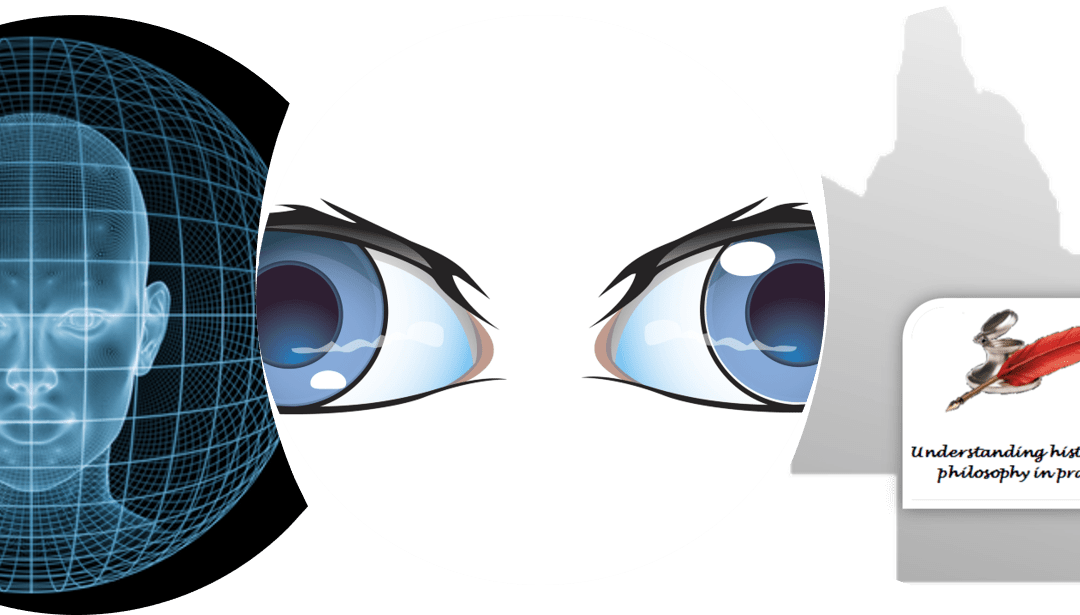
by Neville Buch | Mar 1, 2021 | Intellectual History
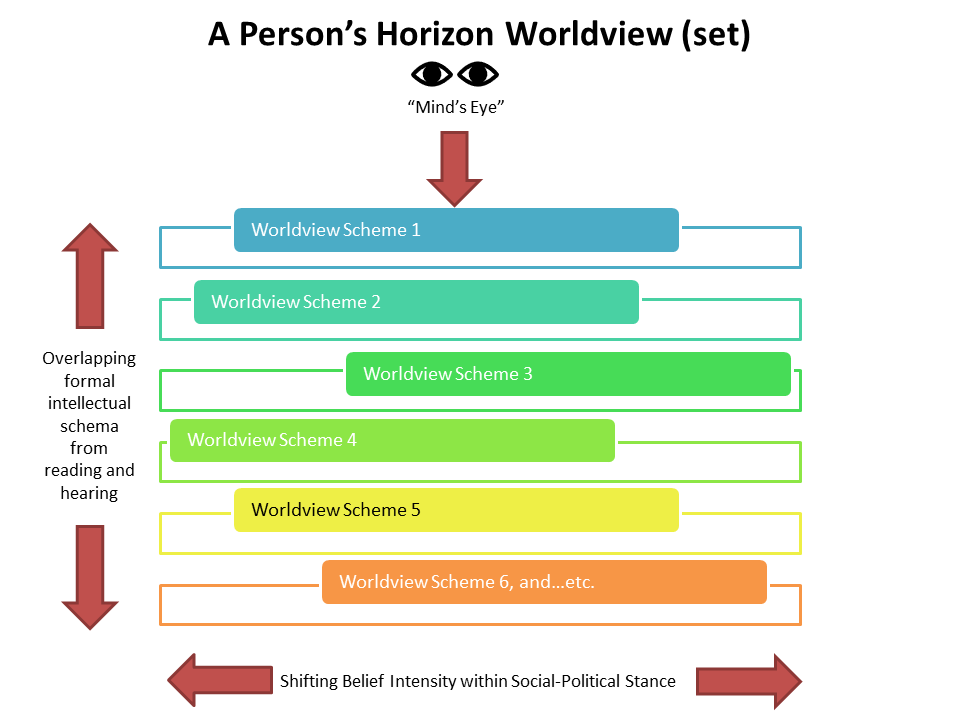
Mind’s Eye Of A Personal Horizon Worldview (Model 1)
This Project, ‘A.03 Book – Horizon Worldviews (Broad Society)’, explains the theory of the psyche-historiographical history, employing the empirical data of Queensland history 1911-2001 to develop the model as understood in a regional-local environment. There are several sociological and philosophy-of-mind models (currently eight). The primary model illustrated above is of the “Mind’s Eye” of a Personal Horizon Worldview. These are all abstract terms, so to the cynic who dismisses anything abstract from the start, and is unaware of their intellectual materialism, all I can say is that you are in a cognitive bubble. Here I offer a much bigger, a global, a universal, cognitive bubble, which greatly reduces the scope of your cynicism.
Currently, the argument works as follows:
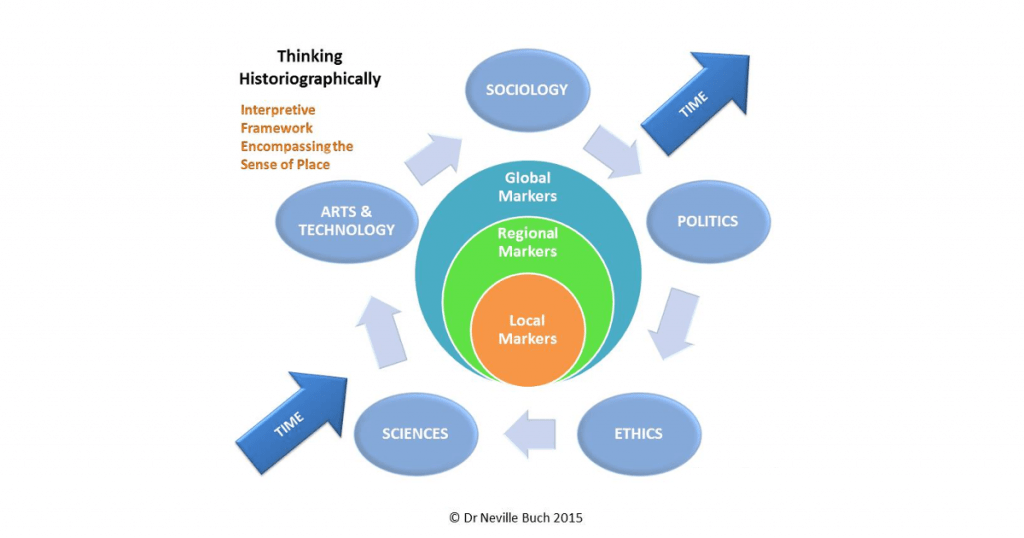
Thinking Historiographically (Model 2)
1.A. Both Personal and Public history, whether authors are aware or not, use the tools of historical sociology. In other words, the generalizations are drawn from the context of each time-space category that we recognise as particularly historical (i.e., each epoch or era, age, and so forth). There is circularity in this reasoning, but it is not the vicious cycle.
1.B. The logical circularity is the necessity of the horizon worldview(s) – the changing limits of our collected cognition. None of us are at the end of time-space, and so what is reasoned will always be diverse, partial, and fallible at any point of time-space. However, the more we collectively push the horizon out, the more we can fit the pieces of the puzzle towards a patchwork horizon worldview (shared sets); where reason works its best.
1.C. The literature here is informed from the field of historiography and identifying the connections with other disciplines.
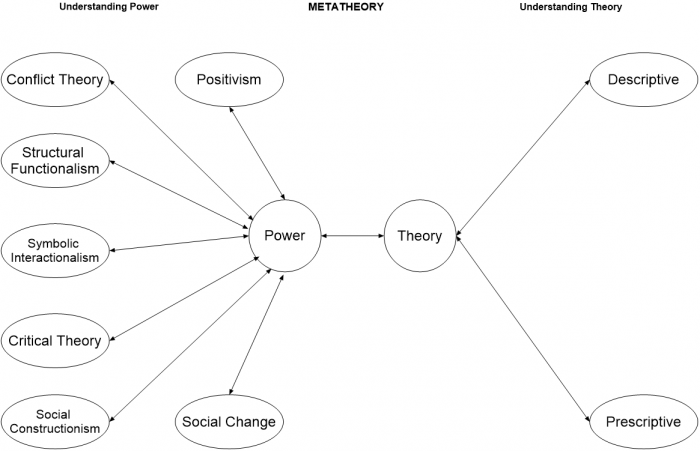
Power Theory (Model 3)
2.A. The nature of being humans is a structure in the relation between power and theory; both abstractly constructs horizon worldview(s). The literature here is informed from two key disciplines, the Sociology of Knowledge, and the History of Knowledge.
2.B. Much is revealed in the history of sociology used as political schema, and whether it is understood by a person or not, by the fact of reading and hearing persons construct their personal horizon worldview with such schema.
2.C. A theory is a contemplative and rational type of abstract or generalizing thinking about a phenomenon, or the results of such thinking. Theories are the links between the subject and the object, as the subject projects upon what is taken as a real world, a prior. Naturalism has its limits in the agent’s thinking, just as much as every personal judgement is limited. The literature on theory is massive, and categorisation of theory can be ‘cut’ in many ways. However, a useful ‘Theory of Theory’ approach would be to consider three terms: Knowledge which is (i) Descriptive and (ii) Prescriptive (normative), and what is called (iii) ‘Metatheory’. This book project is an example of metatheory. It combines the tasks and outcomes from Descriptive (Queensland History data) and Prescriptive/Normative (application of eight social science models) Knowledge and draws a theoretical conclusion (‘Horizon Worldview’). That is a metatheory. The power to do so brings understanding.
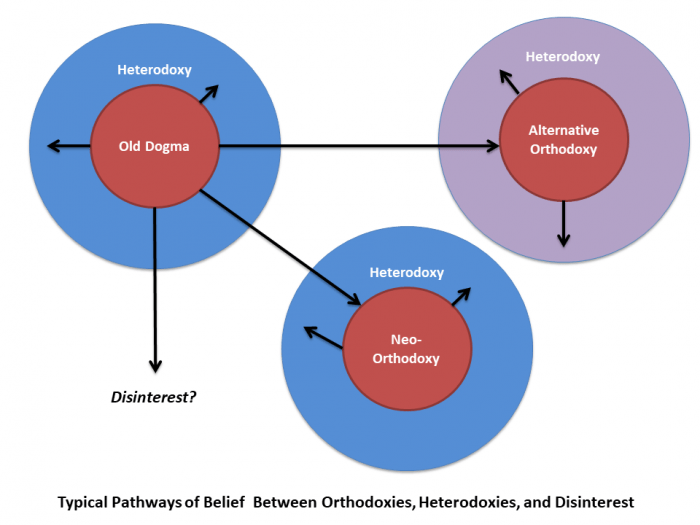
Typical Pathways Of Belief (Model 4)
3.A. At this point of the argument, a cynic will usually dismiss the semantics out-of-hand. The meaning of history (‘semantics’) is entangled in the inherited orthodoxies of childhood, along with abstract cognitive pathways (consciousness, not the depended-neural pathways) which better and creative thinkers search out. The conventional and dull thinker will dwell in the security of old dogmas (including hard materialism). Most believers do not wander far from home, but often are in the territory of heterodoxy unawares — deviation from accepted or orthodox standards or beliefs. All apologia deviates. And as the logic of the argument here points out, the cynic’s dismissive criticism of the semantics is subject to the same problem.
3.B. The cynic then usually objects on the semantics by inferring there has been illegitimate references of religious thought. Secularisation is strongly associated with the exit from established belief to a void of disinterest. However, that is a far too simplification, and merely expresses the prejudice of the conventional and dull thinker as reproduced for the unquestioning behaviourist (‘mind is just a behaviour’) for that choice of oppositional pathway. Whether there are references of religious thought, the dismissive claims are irrelevant; the argument stands on the anti-behavioural thesis of the Emergent Consciousness (e.g., David Chalmers). The cynic has not read his subject well-enough to understand what is going on as knowledge and meaning.
3.C. For the thoughtful believers of any system, the choice is typically to move within the same system to a neo-orthodoxy or to find an alternative. Again, there are secondary pathways within a sphere of heterodoxy, built upon the new orthodoxy or the alternative orthodoxy of another system.
3.D. The meaning of history is derived from mapping these pathways, which can be judged as progressive, a move in time for the better, or regressive, a move to a situation judged poorly from one or another stance on the map. Beliefs and doubts in history are important. Humans do not merely behave between input and output, unless a person, actually, does have their mind switched off (normatively not possible).
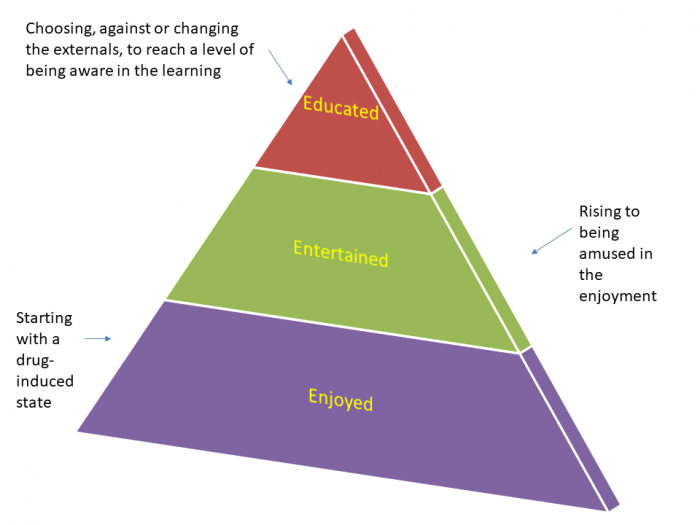
Buch’s Pyramid Of Social Personal Development (Model 5)
4.A. The Behaviourist counter-model cannot be dismissed out-of-hand. We play to better critical thinking rules than the cynic. The alternative model, to counter the Behaviourist counter-model, is the Buch’s Pyramid of Social-Personal Development Model:
4.A (i). Most of persons are bound to a work routine, where evaluation of the time is beyond our agency – we do what we do because…many external reasons beyond our control. For their leisure hours, most persons, for most amount of time, do not go beyond enjoyment. There is a drug-induced state, natural mechanisms of the human body, whether added to by pharmaceutical or leisure (alcohol and other pain-killing habits) substances or not.
4.A (ii). The better side of humanity rises to another level. There is some effort towards entertainment, which is a state of being amused and having passed the time more enjoyable than the drug-induced state. It is a state of the emergent consciousness in deliberate judgement. Unfortunately, less of the population rise to this level.
4.A (iii). The even better side of humanity, although fewer reach this level, is the state of being educated. It is the emergent consciousness in deliberate judgement, as also to be entertained, but it has the added dimension of critical awareness, the awareness that, I as a person, have learnt something.
4.A (iv, the analysis of the three levels). One of the problems in Mill’s pleasure principle is that pleasure is obtained at all three levels. Pleasure becomes meaningless if it is all things. Mill did try to resolve the problem with his pig satisfied and Socrates unsatisfied principle, but the argument appears to demonstrate that pleasure is not sufficient, even if we have Socrates with unsatisfied pleasure. The same problem exists for the concept of happiness in the American constitutional writers’ argument on what happiness is for the sake of governance. It may be educatively elitist, but with the bounded work routine, externally imposed, there is choice. It is the choice of resistance and dissent. Hence, the invitation for both changes in the externals and the internal reasoning.
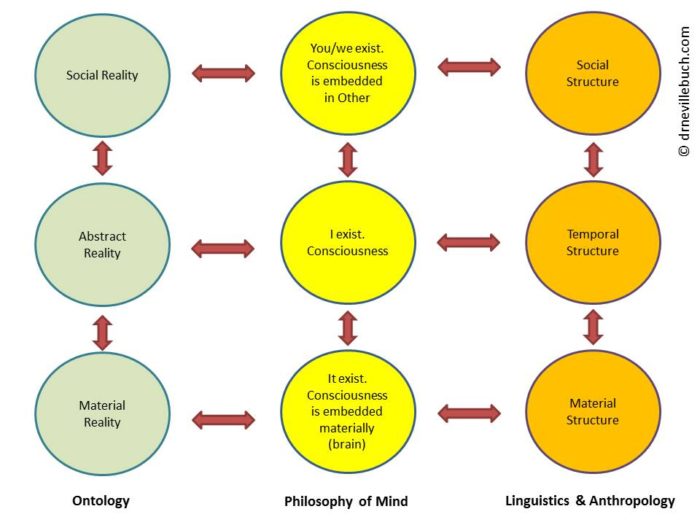
Interrelation Of Ideas On Consciousness And Reality (Model 6)
5.A. Different fields of philosophy and the humanities investigate the same ideas which have been so far explored in the book project. The purpose of Buch’s ‘Interrelation of Ideas on Consciousness and Reality Model’ (as illustrated) is to demonstrate the interrelation of ideas on consciousness and reality across three fields, and to show that the interrelation rejects the extreme positioning, one which articulates too simplistic dichotomies, and the other to reduce everything to the one idea or thing.
5.B. The cynic then usually objects on the philosophy-of-mind employed in the model. The cynic misunderstands the philosophers who continue to argue that the idea of self, personal identity, or ego, is an illusion. What has gone unnoticed in the Cynic’s objection is that ‘what it is to have an illusion’ requires a closed model, as the type used in this book project. ‘I’ believe that the talk of ontological illusion is confused. What is understood as ‘illusion’ is a trick to prevent a reality being perceived. A magician’s illusion is only understood when the trick is revealed against the background of reality. The magician had temporally been successful to elude our view of what she is really doing. When the trick is revealed we see that we have fallen for an illusion because there was something really happening which we were not perceiving. Hence, I cannot see how “self, personal identity, or ego,” is an illusion in any ordinary meaning. How is it possible to perceive that I do not exist, that I only have an illusion of existing, when it is ‘I’ that is the thinking thing which is doing the perceiving? The only logic which would work is that of a closed model and where the semantics of the ‘illusion’ is not normative.
5.C. There are three possible counter-arguments here: (i) A Knowable ‘God’, nirvana, or some ‘Other’ from where the perception lies and ‘I’ am merely the dream or the idea of that perception; The second and third possible manoeuvres are to point to the misapprehension in language; (ii) One option is to then to dismiss all metaphysics as unworthy of any serious comment; (iii) The other option, and the third manoeuvre, is to conclude that the logic of language does not reveal what is happening, and so we must abandon ‘logicentrism’. In the book project rebuttals are considered.
5.D. From that central idea of critical thinking, we have another metatheory. It is how the interrelation model demonstrates the problem in the ‘common sense’ worldview, and often as the worldview that is referred to as modernity. This view (e.g., starting from David Hume) is a counter-argument to the other major alternatives of the ancient world: (i) Solipsism – concluding that only ‘I exist’ or anything else is of no importance; and (ii) Immaterialism – concluding that only the idea exist and there is no material substance. In the modern world, those with cynical stances will attempt to argue that the book project ‘anti-realist’ options (the term ‘anti-realist’ is often misunderstood and is not solipsism or immaterialism as used in the term here) have become no more than epistemological exercises; thus, in common usage, no sane person will deny that other persons exist, or that we live only in a hard material world. The book project shows how these ancient ways of thinking, and now as the modern ‘common sense’, are logical fallacies and demonstrated in critical thinking.
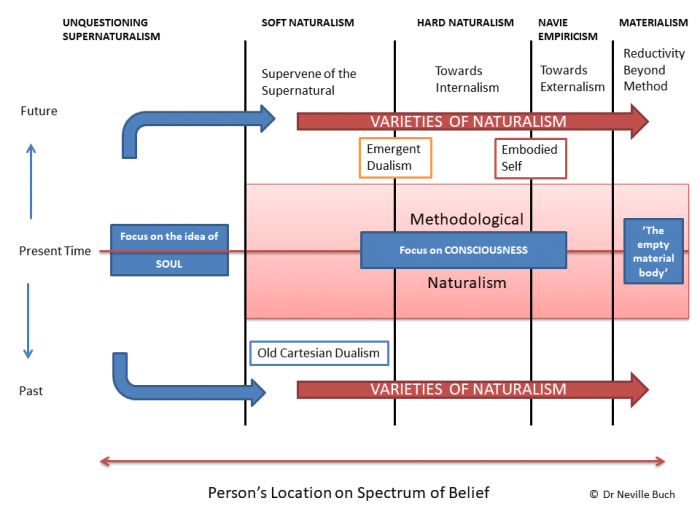
Persons’ Belief In Mind-Brain Spectrum (Model 7)
6.A. The Buch’s ‘Mapping Locations on the Mind-Brain Belief Spectrum’ model reframes the same argument of Buch’s ‘Interrelation of Ideas on Consciousness and Reality Model’, but addresses the Cynic with a positive alternative to the cynicism; in other words, if the cynic is wrong on their Mind-Brain model, what is a working model? Here is how the model works:
6.A (i). In the model there is the abstract movement from left to right which are possibilities of belief from an unquestioning supernaturalism to an empty materialism. Supernaturalism hangs on the ancient idea of soul but it is possible to carry that concept into a soft naturalism. The difference between the ancient conceptions along with, today, the thinking of naive modern fundamentalists, against the rest of our population, is that the supernationalism is so unquestioned that it has what most consider as a comical character. God is a comedian or superhero or super villain, quite literally.
6.A (ii). As soon as a methodological naturalism is adopted – and it begins with the ancients – it changes the game completely. Naturalism is basically the argument that supernatural entities – what we determine is above/outside the ordinary patterns (of science or common sense observation) – has no bearing on judgement. However, judgement can consistently work as compatibly between opposing principles or basic beliefs. Apparent contradictions might be resolved in a different rearrangement than what came before. Methodological naturalism is often the rearrangement – rearrange natural features into a theory without recourse to supernatural items.
6.A (iii). Therefore, it is common to have modern neo-evangelical Christian believers who articulate a soft naturalism via sufficient methodological naturalism where the supernatural supervenes, as a belief, which has no part of a naturalistic explanation. The structure of the belief frame can be seen in Stephen Jay Gould’s non-overlapping magisteria (NOMA).
6.A (iv). However, there is a further step that both Christian and Post-Christian believers have taken, and into a harder naturalism. The step is taken when a serious concept of ‘soul’ is abandoned for a focus on consciousness. Soul is now the empty metaphor, although useable as a literary device to describe ‘the spirit’, what is much better conceptualised as person or consciousness. Here is the complete abandonment of the Cartesian dualism, which, to the modern enquiring mind, appears as comical as the ancient soul.
6.A (v). However, it is still possible to retain a basic duality of mind and body where the mind is what we describe as what emerges/emerged in brain activity. At this stage of the spectrum there is greater latitude in explanation, for the very reason that ‘consciousness’ is a relatively new field and there is still considerable uncertainty or contention. Specifically, there are highly technical internalist-externalist debates which extend over into the fields of ontology, meta-ethics and epistemology. Currently, the idea of the ‘embodied self’ extents across the divide, but the more one pushes into a radical or naïve empiricism, which reject more and more of the theoretical components for the trust in the observational statements, the more the concept of ‘self’ is abandoned. When it is completely abandoned, we are left with ‘the empty material body’. There is no internal reasoning but only external judgement.
6.A (vi). The arrival in materialism also rejects any notion of duality or any layering beyond material existence. Materialism here might be better described as hard materialism whereas hard empiricism can be seen as a softer materialism with the possibilities of the observing self. The reduction move – cutting back the layers of internal reasoning – in the methodological naturalism has reached an absolute in the radical materialism.
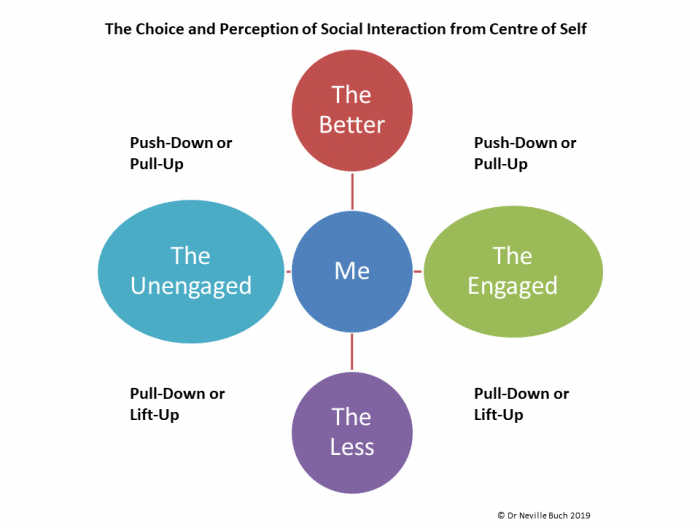
The Choice Perception Of Social Interaction (Model 8)
7.A. The Buch’s ‘Choice and Perception of Social Interaction from Centre of Self’ Model brings the book project to a conclusion and brings the history of Queensland out more formatively. What is not understood in Queensland history was there were many, many, historical players engaged in theories of personality and philosophical ideas of what made a person. This involved leading philosophers in Queensland, but it also involved many ordinary residents of the state who did not have the philosophical language. The model simply states that historical players have agency. Each person has had the capacity to divert from the script of time-space as we have once read history. Hard Determinism is an intellectual scheme which reads history backwards but fails to understand the concept of the present moment in the history-making. What choice was available to historical players is a key question for the better historian. This is the philosophical sub-field known as the study of ‘agency’. The model here offers an answer. The agency is potentially there for the historical player to be (i) cognitively engaged (meaning both thinking and passion/emotion as the one neural process: a set of processes) or unengaged; and (ii) to operate in an ethical framework which lift up or push/pull down “the betters” or “the less”.

Queensland Horizon Worldview(s)
This is the way to assess Queensland history, and combines the resources of historiography, social psychology, and several branches of philosophy.
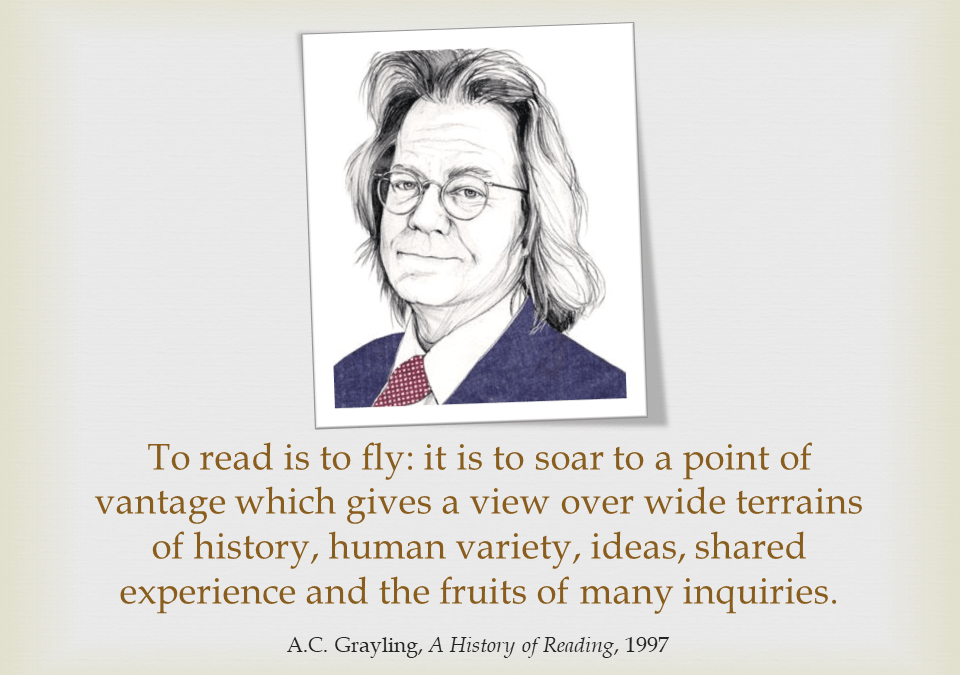
by Neville Buch | May 14, 2024 | Concepts in Educationalist Thought Series
The first in a series of articles about how today’s traditional-age college students experience the world — and how it affects their education.
Theresa MacPhail is a pragmatist. In her 15 years of teaching, as the number of students who complete their reading assignments has steadily declined, she has adapted. She began assigning fewer readings, then fewer still. Less is more, she reasoned. She would focus on the readings that mattered most and were interesting to them.
For a while, that seemed to work. But then things started to take a turn for the worse. Most students still weren’t doing the reading. And when they were, more and more struggled to understand it. Some simply gave up. Their distraction levels went “through the roof,” MacPhail said. They had trouble following her instructions. And sometimes, students said her expectations — such as writing a final research paper with at least 25 sources — were unreasonable.
So, goes the reading of the opening paragraphs in Beth McMurtrie’s Is This The End of Reading? The Chronicle of Higher Education, MAY 9, 2024. The problem may have different elements but it does appear to come down to the issue of the entertainment mindset: a refusal to actually learn for a drug-like need to be entertain:
“If you make it easier, and go over what they should have read in class, students will participate. But then what are you doing, other than entertaining?”

Buch’s Pyramid Of Social Personal Development 700×525
It might be a waste of time to share this message with those who are actually reading what I am saying here. The persons who are caught up in the entertainment mindset, or drugged out their brain, are the persons who need assistance in changing their habits. There are many different guides to the practice of reading, some with substantive theory and other articles to be read with weak theoretical reading. In the References below are a selection of the reading, and the quality of the reading for each article I will leave up to the reader. As for Jennifer Rowsell and Anne Burke (2009), there are different types of learners when it comes to readers. Allow me to demonstrate one case of a misreading from one type of a poor learner, from Richard Cimino and Christopher Smith (2007).
Their primary and key message is:
“In conclusion, the secular humanist and atheist patterns of interaction and conflict discussed in this article suggest that these freethinkers’ hopes and visions of a secular America have been of little use in sustaining an identity within a highly religious (though pluralistic) society. In fact, the real and imagined culture wars and the forging of a subcultural identity may turn out to benefit the secular humanist movement far more than the much hoped for eclipse of faith and dawn of a humanist twenty-first century.” (2007: 424).
As the philosophical state of affairs within the United States, Richard Cimino and Christopher Smith (2007) have read correctly. As understanding global humanism, Cimino and Smith are very incorrect, dead wrong, and I can think of stronger language. The whole article is dominated by an American cultural way of thinking, I call the “American Revivalist Tradition” (ART). As the correct state of affairs Richard Cimino and Christopher Smith claim (2007: 407) for humanism:
- creating a niche for secular humanism among the unchurched and “secular seekers”;
- mimicking and adaping various aspects of evangelicalism, even as they target this movement as their main antagonist; and
- making use of minority discourse and identity politics.
Now, the reading mindset is entertainment for Richard Cimino and Christopher Smith because they get enjoyment out of the American cultural way of thinking. For global humanism, their ideals of Americanised humanism, makes humanists sick to the core. The American thinkers reject niches and “finding a place at the table.” Rather what they want is for “secularism to become a dominant force in the United States” and they are decrying the failure against compassionate and kind strategies (407).
The cultural and reading attitude is what A.C. Grayling rejects in the quote, but, more than that, it teaches how to read:
” To read is to fly: it is to soar to a point of vantage which gives a view over wide terrains of history, human variety, ideas, shared experience and the fruits of many inquiries “
REFERENCE
Cimino, R., & Smith, C. (2007). Secular Humanism and Atheism beyond Progressive Secularism. Sociology of Religion, 68(4), 407–424. http://www.jstor.org/stable/20453183
DelConte, M. (2003). Why You Can’t Speak: Second-Person Narration, Voice, and a New Model for Understanding Narrative. Style, 37(2), 204–219. http://www.jstor.org/stable/10.5325/style.37.2.204
Hamington, M. (2015). Care Ethics and Engaging Intersectional Difference through the Body. Critical Philosophy of Race, 3(1), 79–100. https://doi.org/10.5325/critphilrace.3.1.0079
Jackson, I. (2004). Approaches to the History of Readers and Reading in Eighteenth-Century Britain. The Historical Journal, 47(4), 1041–1054. http://www.jstor.org/stable/4091667
Jolley, K. (2008). Video Games to Reading: Reaching out to Reluctant Readers. The English Journal, 97(4), 81–86. http://www.jstor.org/stable/30047252
Kort, W. A. (2013). Calvin’s Theory of Reading. Christianity and Literature, 62(2), 189–202. http://www.jstor.org/stable/44324128
Newell, G. E., Beach, R., Smith, J., VanDerHeide, J., Kuhn, D., & Andriessen, J. (2011). Teaching and Learning Argumentative Reading and Writing: A Review of Research. Reading Research Quarterly, 46(3), 273–304. http://www.jstor.org/stable/41228654
Robertson, J. E. (1968). Pupil Understanding of Connectives in Reading. Reading Research Quarterly, 3(3), 387–417. https://doi.org/10.2307/747011
Stivers, C. (1994). The Listening Bureaucrat: Responsiveness in Public Administration. Public Administration Review, 54(4), 364–369. https://doi.org/10.2307/977384
Sweeney, M. A., & McBride, M. (2015). Difficulty Paper (Dis)Connections: Understanding the Threads Students Weave between Their Reading and Writing. College Composition and Communication, 66(4), 591–614. http://www.jstor.org/stable/43491902
Rowsell, Jennifer, and Anne Burke. “Reading by Design: Two Case Studies of Digital Reading Practices.” Journal of Adolescent & Adult Literacy 53, no. 2 (2009): 106–18. http://www.jstor.org/stable/40344356.
Vallecorsa, A. L., & deBettencourt, L. U. (1997). Using a Mapping Procedure to Teach Reading and Writing Skills to Middle Grade Students with Learning Disabilities. Education and Treatment of Children, 20(2), 173–188. http://www.jstor.org/stable/42899487
Wolf, M. (2018). The science and poetry in learning (and teaching) to read. The Phi Delta Kappan, 100(4), 13–17. https://www.jstor.org/stable/26552479
Wu, S., & Pope, A. (2019). Three-Level Understanding: Recovering Self-Awareness in the Art of Critical Thinking. Journal of Thought, 53(1 & 2), 21–37. https://www.jstor.org/stable/26727283
Featured Image:
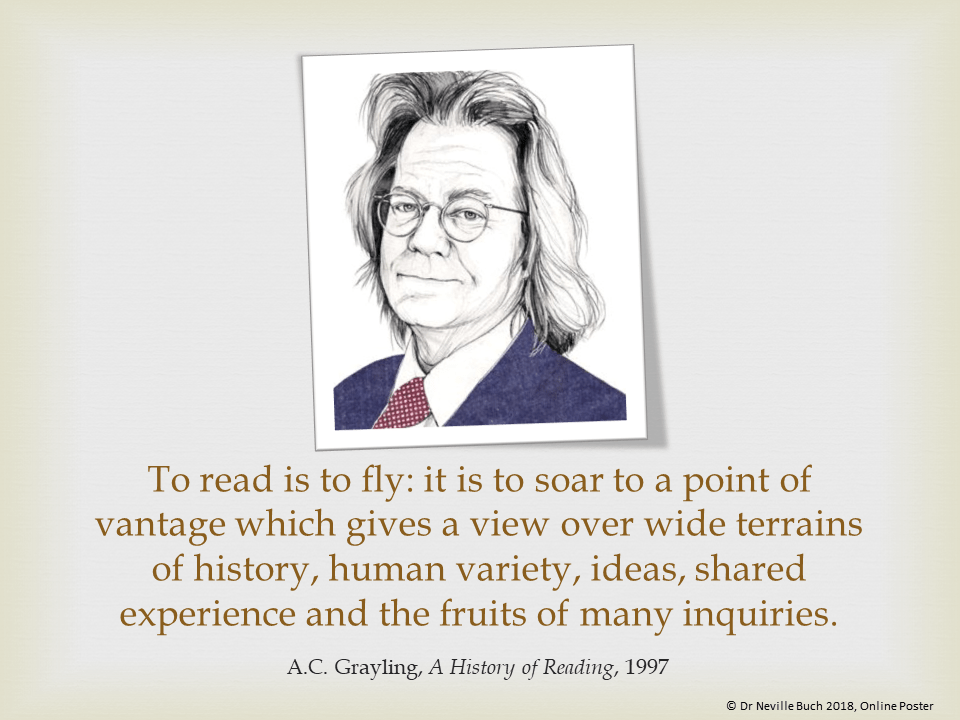
Slide 026. Grayling On Reading

by Neville Buch | Feb 14, 2024 | Concepts in Educationalist Thought Series, Concepts in Public History for Marketplace Dialogue, Letter
Dear Friends,
I had made inquiries on the particular higher education policy reforms which were occurring, from the position of the federal government. I sent my enquiry off, back in October, to the PMO and it was redirected straight away to the department. I had no answer until today.
The answer is we will have to wait until the end of the year and then some.
In the meantime small businesses go bankrupt, persons lose their houses, and the suicide rate goes up or persons are committed to mental health facilities.
Who cares is the critical question and it demands precise answers.
—
Kind regards,

Neville Buch
Historian,
Professional Historians Australia (Queensland)
Australian and New Zealand History of Education Society (ANZHES)
Convenor, Sociology of Education Thematic Group, The Australian Sociological Association (TASA).
President, Southern Brisbane Suburban Forum (SBSF).
Director, Brisbane Southside History Network (BSHN).
MPHA (Qld), Ph.D. (History) UQ., Grad. Dip. Arts (Philosophy) Melb., Grad. Dip. (Education) UQ.

———- Forwarded message ———
From: Education – HEenquiries <[email protected]>
Date: Wed, 14 Feb 2024 at 10:42
Subject: Re: NO ANSWER from the Department of the Prime Minister and Cabinet: CAS-648023-H2R8Z7 CRM:0001392
To: Neville Buch <[email protected]>
Dear Dr Buch,
We have forwarded your enquiry to the Australian Universities Accord team at [email protected] for response.
As you may be aware, the Government committed to an Australian Universities Accord (the Accord), a 12-month Review of Australia’s higher education system (the Review) led by an expert panel to drive lasting and transformational reform in the higher education sector.
The Accord Panel provided an Interim Report to Government in June 2023, released by the Hon Jason Clare MP, Minister for Education on 19 July 2023. The intention was to build a broad platform for change across the entire spectrum of higher education in ways that will benefit all Australians. To do this, the Interim Report presented over 80 considerations for change for further exploration and testing ahead of the Final Report.
The Minister for Education received the Accord’s Final Report on 28 December 2023 and intends to release the report in due course. Further information on the Accord, including a copy of the Interim Report and news on the pending release of the Final Report, is available at www.education.gov.au/australian-universities-accord.
Kind regards,
[name removed]
Higher Education Enquiries Team
Australian Government Department of Education
[email protected]
www.education.gov.au | www.studyassist.gov.au
——————- Original Message ——————-
From: Neville Buch;
Received: Tue Feb 13 2024 15:06:05 GMT+1100 (Australian Eastern Daylight Time)
To: HEenquiries; ;
Subject: Re: NO ANSWER from the Department of the Prime Minister and Cabinet: CAS-648023-H2R8Z7 CRM:0001392
Dear Federal Education Officer,
I still have not had a substantive reply or answer to my email and phone calls since the 16th November 2023.
It has been so long, it would take some work to find the original enquiry, but the question was fairly straight forward:
What higher education policy reform is in-train for the current parliamentary period?
Surely, that is not too difficult for the federal government to answer through the HE bureaucracy.
I have several Queenslanders who are eager for your clear answer.
Kind regards,
Neville Buch.
On Thu, 16 Nov 2023 at 14:33, Education – HEenquiries <[email protected]> wrote:
Thank you for contacting the Higher Education Enquiries team.
Reference number CAS-648023-H2R8Z7 .
The department will endeavour to reply within 10 working days. In the meantime, you may find the below information can assist with your enquiry.
If you are interested in study, talk directly to the provider where you want to apply to find out if you are eligible for a HELP loan or a Commonwealth supported place (CSP).
If you want to withdraw from your study, this must be done before the census date. Submit your provider’s withdrawal form as soon as possible to avoid incurring a HELP debt.
Log in to the ATO’s online services via myGov to see how much you owe on your HELP debt or find out more about repaying your HELP loan through the tax system.
To find out your HELP limit and available HELP balance, log in to the myHELPbalance portal.
If you think that you have been charged incorrectly, you must contact your university or education provider to dispute the debt.
Kind regards,
[name removed]
Higher Education Enquiries team
Australian Government Department of Education
[email protected] | www.studyassist.gov.au
Notice:
The information contained in this email message and any attached files may be confidential information, and may also be the subject of legal professional privilege. If you are not the intended recipient, any use, disclosure or copying of this email is unauthorised. If you received this email in error, please notify the sender by contacting the department’s switchboard on 1300 566 046 during business hours (8:30am – 5pm Canberra time) and delete all copies of this transmission together with any attachments.
















